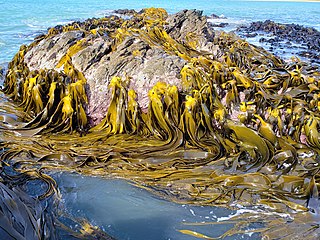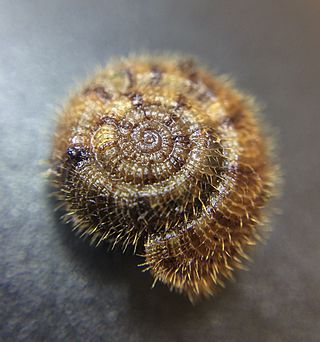
Rhytididae is a taxonomic family of medium-sized predatory air-breathing land snails, carnivorous terrestrial pulmonate gastropod molluscs in the superfamily Rhytidoidea.

Placostylus hongii is a species of very large, air-breathing land snail, a terrestrial pulmonate gastropod mollusc in the family Bothriembryontidae.

Amalda australis, common name the southern olive, is a medium-sized sea snail, a gastropod mollusc of the family Ancillariidae. These predatory snails live in the inter-tidal sand, an environment that lends itself to high probability of fossilization. Amalda australis fossils date back to the Pliocene and reveal morphological stasis.

Amalda mucronata is a species of medium-sized sea snail, a marine gastropod mollusc in the family Ancillariidae. These snails live in the sandy subtidal near-shore environment where they eat bivalves. Fossil material of this species provides evidence of morphological stasis over 5 million years

Durvillaea is a genus of large brown algae in the monotypic family Durvillaeaceae. All members of the genus are found in the southern hemisphere, including Australia, New Zealand, South America, and various subantarctic islands. Durvillaea, commonly known as southern bull kelps, occur on rocky, wave-exposed shorelines and provide a habitat for numerous intertidal organisms. Many species exhibit a honeycomb-like structure in their fronds that provides buoyancy, which allows individuals detached from substrates to raft alive at sea, permitting dispersal for hundreds of days over thousands of kilometres. Durvillaea species have been used for clothing, tools and as a food source by many indigenous cultures throughout the South Pacific, and they continue to play a prominent role in Chilean cuisine.

Durvillaea antarctica, also known as cochayuyo and rimurapa, is a large, robust species of southern bull kelp found on the coasts of Chile, southern New Zealand, and Macquarie Island. D. antarctica, an alga, does not have air bladders, but floats due to a unique honeycomb structure within the alga's blades, which also helps the kelp avoid being damaged by the strong waves.

Durvillaea willana is a large species of southern bull kelp endemic to New Zealand.
Lepidopleurus is an extant genus of chitons in the family Leptochitonidae.

Sypharochiton pelliserpentis is a species of chiton in the family Chitonidae. As the species name suggests, the surface of the girdle in this chiton has a pattern of overlaying scales resembling snakeskin.

Onithochiton is a genus of chitons in the subfamily Toniciinae of the family Chitonidae, which is distributed from Australia and New Zealand to South Africa.
Onithochiton neglectus opiniosus is a subspecies of chiton in the family Chitonidae.
Onithochiton neglectus subantarcticus is a subspecies of chiton in the family Chitonidae.

Pleurobranchaea maculata, or the grey side-gilled slug, is a species of sea slug, specifically a side-gill slug or notaspidean. It is a marine gastropod mollusc in the family Pleurobranchaeidae.

Cominella virgata is a species of predatory sea snail, a marine gastropod mollusc in the family Cominellidae.

Onchidella marginata is a species of air-breathing sea slug, a shell-less marine pulmonate gastropod mollusk in the family Onchidiidae.

Bufonaria perelegans is a species of sea snail, a marine gastropod mollusk in the frog shellfamily, Bursidae.

Orocrambus abditus is a moth of the family Crambidae. It was first described by Alfred Philpott in 1924. It is endemic to New Zealand and can be found in Marlborough, Arthur's Pass, and in Canterbury. The species inhabits grassland including tussock grassland and shrubland. Larvae have been collected in October and the adults of this species are on the wing from October to March.

Suteria ide is a species of air-breathing land snail, a terrestrial gastropod mollusc in the family Charopidae .This species is endemic to New Zealand.

Desis marina, the intertidal spider, is a spider species found in New Zealand, New Caledonia, and the Chatham Islands.
















